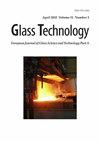Semiconducting and scintillating glasses for x-ray detection
IF 0.3
4区 材料科学
Q4 MATERIALS SCIENCE, CERAMICS
Glass Technology-European Journal of Glass Science and Technology Part a
Pub Date : 2023-04-06
DOI:10.13036/17533546.64.2.04
引用次数: 0
Abstract
X-ray detectors are commonly used for medical, crystallography and space physics applications. Most of the current x-ray detectors use cadmium zinc telluride (CZT) as the active medium. This report investigates high density semiconducting and scintillating glasses as potential alternatives to CZT. For the semiconducting glasses, samples composed of xCuO–((1−x)/2)PbO–((1−x)/2)V2O5 and xFeO–((1−x)/2)PbO–((1−x)/2)V2O5, for the scintillating glasses, samples composed of xGd2O3+yWO3+(1−x−y)2H3BO3, doped with 1–6% Eu3+ or Tb3+, were investigated in this study. The glass-making conditions, density, Raman spectroscopy analysis, photoluminescence excitation and emission spectra, as well as conductivity measurements performed on various samples, are reported. The interaction of x-rays with all the glass samples was simulated using GATE software, and their mass attenuation coefficients were calculated and compared with CZT.x射线探测用半导体和闪烁玻璃
x射线探测器通常用于医学、晶体学和空间物理应用。目前的x射线探测器大多采用碲化镉锌(CZT)作为活性介质。本报告探讨了高密度半导体和闪烁玻璃作为CZT的潜在替代品。对于半导体玻璃,研究了xCuO -((1−x)/2)PbO -((1−x)/2)V2O5和xFeO -((1−x)/2)PbO -((1−x)/2)V2O5组成的样品,对于闪烁玻璃,研究了xGd2O3+yWO3+(1−x−y)2H3BO3组成的样品,掺杂1 - 6%的Eu3+或Tb3+。报道了玻璃的制造条件、密度、拉曼光谱分析、光致发光激发和发射光谱以及对各种样品的电导率测量。利用GATE软件模拟了x射线与所有玻璃样品的相互作用,计算了它们的质量衰减系数,并与CZT进行了比较。
本文章由计算机程序翻译,如有差异,请以英文原文为准。
求助全文
约1分钟内获得全文
求助全文
来源期刊
CiteScore
0.30
自引率
0.00%
发文量
0
审稿时长
>12 weeks
期刊介绍:
The Journal of the Society of Glass Technology was published between 1917 and 1959. There were four or six issues per year depending on economic circumstances of the Society and the country. Each issue contains Proceedings, Transactions, Abstracts, News and Reviews, and Advertisements, all thesesections were numbered separately. The bound volumes collected these pages into separate sections, dropping the adverts. There is a list of Council members and Officers of the Society and earlier volumes also had lists of personal and company members.
JSGT was divided into Part A Glass Technology and Part B Physics and Chemistry of Glasses in 1960.

 求助内容:
求助内容: 应助结果提醒方式:
应助结果提醒方式:


